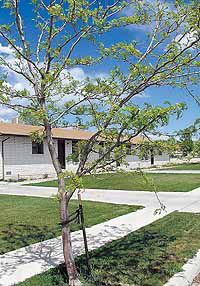| Honeylocus trees grow well in Price |
Trees are a large investment in any garden or yard and its important to select trees that are compatible with the climate they will grow in. A great guide to trees is a Utah State University Extension book titled, “Selection and Culture of Landscape plants in Utah.” This is a guide for Castleland County, which includes Carbon and Emery counties. The book is written by Larry Rupop and Dana Libbey and provides an excellent selection of trees that can grow in this part of Utah.
According to local extension agent Marlon Winger, using this book as a source suggess the top 10 trees for Carbon County:
1. Green Ash
2. Idaho Flowering Locust
3. Kentucky Coffeetree
4. Thornless Honeylocust
5. Bruce Spruce
6. Austrian Pine
7. London Planetree
8. Callery Flowering Pear
9. Littleleaf Linden
10. Golden Raintree
Winger explained that it is hard to find the perfect one. There are faults in all of these and any of these will have problems without proper management.
These are not in a specific order and did indicate that Lyle Bauer, who manages the Price City cemetery is a local person who understands trees very well.
Trees that are adapted to this area are researched locally through the land grant college, not a tree salesperson from out of state. A good example is the Quakie Aspen, which according to Winger, “is a lovely mountain tree but has a lot of problems in the valley floor.” Yet it’s one of the trees that many of the department store nurseries promote.
The book begins, “What traveler, driving across Utah, has not marveled at its diversity of geography, climate and vegetation? From Joshua trees in the Mojave Desert, to alpine meadows, to pinion-juniper forests set against the red sandstone of the Colorado Plateau, it is truly a state of contrasts.
“Ideally, Utah landscapes should be adapted to local conditions and enhance the natural beauty of the state. Unfortunately, most of our landscapes are patterned after those found in Europe or Northeastern America. Such landscapes are difficult to maintain and require more resources, such as water and fertilizer, than adapted landscapes.
While there are no simple design recommendations that would be valid state-wide, localized guidelines can address the diversities of climate, soils, and other factors which affect plant growth.”
Thornless Honeylocust
• Deciduous with green compound leaves with small leaflets.
• Fast growth to 40 feet by 40 feet, full sun.
• Tolerant to high pH and salt.
• Provides light shade, no heavy leaf litter.
• Susceptible to midge pod gall and thionectria canker.
Kentucky Coffeetree
• Deciduous with large, green, doubly pinnate leaves.
• Slow to establish and grows to 60 feet by 40 feet.
• Full sun.
• Adaptable to soil conditions, but prefers deep loam. Tolerates urban conditions.
• No serious diseases or insects. Female trees will produce seedpods.
• Good tough tree.
Golden Raintree
• Deciduous with green, compound leaves and yellow fall color.
• Yellow flowers in mid-summer are followed by conspicuous seed pods.
• Moderate growth rate to 30feet to 30 feet.
• Full sun.
• Soil and pH adaptable.
• Tolerant of harsh, urban conditions.
• No serious insects or diseases.
Green Ash
• Deciduous with green, compound leaves and yellow fall color.
• Fast growth to 40 foot by 30foot, full sun. Tolerant of salt, high pH, and poor soils.
• Select seedless varieties only. Susceptible to Ash borer which can cause significant damage.
• “Patmore” is a hardier selection.
Blue Spruce
• Evergreen native with green to blue foliage.
• Slow growing to 40feet by 15feet, full sun.
• Must account for eventual size of this tree when planting in landscape, only pest is the spruce gall adelgid, which is mainly a cosmetic problem.
Austrian Pine
• Evergreen with long, dark green needles.
• Moderate growth rate to 45 feet by 25 feet.
• Full sun.
• Tolerant of city conditions, soils, heat, and alkalinity.
• No serious insect or disease problems.
London Planetree
• Deciduous, large, green leaves with no fall color.
• Decorative scaling bark.
• Moderate growth rate to 70 feet by 70 feet.
• Full sun.
• Tolerant of soil type, air pollution, and pH.
• Problems with cankerstain, anthracnose, and frost cracking. Choose selected cultivars.
Callery Flowering Pear
• Deciduous. Small, formal tree with moderate growth to 30 feet by 20 feet.
• White flowers in spring with no fruit.
• Adaptable to varying soil types, narrow crotch angles lead to breakage.
• No serious insect problems, though fire blight can be severe.
Idaho Flowering Locust
• Deciduous, green leaves; attractive purple blossoms.
• Fast growing to 50 feet by 30 feet, full sun.
• Tolerant to a wide range of soils, good for use in difficult areas, susceptible to borers.
Littleleaf Linden
• Deciduous, often pyramidal-shaped tree.
• Grows to 60 feet by 30 feet.
• Easily transplanted.
• Full sun.
• Prefers well-drained soil and is soil-pH tolerant.
• Aphids can be a problem.
• Excellent shade tree with several nice cultivars.

